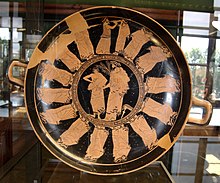
Back Rooifiguurstyl Afrikaans الفخار ذو الشكل الأحمر Arabic Ceràmica de figures vermelles Catalan Červenofigurový styl Czech Хӗрлӗ кӗлеткеллӗ ваза ӳнерӗ CV Rødfigurs-keramik Danish Rotfigurige Vasenmalerei German Ερυθρόμορφος ρυθμός Greek Ruĝfigura ceramiko Esperanto Cerámica de figuras rojas Spanish


Red-figure pottery is a style of ancient Greek pottery in which the background of the pottery is painted black while the figures and details are left in the natural red or orange color of the clay.
It developed in Athens around 520 BCE and remained in use until the late 3rd century BCE. It replaced the previously dominant style of black-figure pottery within a few decades. Its modern name is based on the figural depictions in red color on a black background, in contrast to the preceding black-figure style with black figures on a red background. The most important areas of production, apart from Attica, were in Southern Italy. The style was also adopted in other parts of Greece. Etruria became an important center of production outside the Greek World.
Attic red-figure vases were exported throughout Greece and beyond. For a long time, they dominated the market for fine ceramics. Few centers of pottery production could compete with Athens in terms of innovation, quality and production capacity. Of the red-figure vases produced in Athens alone, more than 40,000 specimens and fragments survive today. From the second-most important production center, Southern Italy, more than 20,000 vases and fragments are preserved. Starting with the studies by John D. Beazley and Arthur Dale Trendall, the study of this style of art has made enormous progress. Some vases can be ascribed to individual artists or schools. The images provide evidence for the exploration of Greek cultural history, everyday life, iconography, and mythology.
© MMXXIII Rich X Search. We shall prevail. All rights reserved. Rich X Search